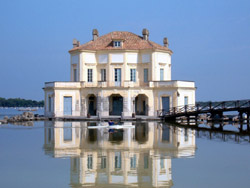
Vanvitelli hunting lodge on the lake Fusaro |
PHLEGRAEAN FIELDS
Pozzuoli:
Pozzuoli became a colony of Samos in the second part of the VI century B.C.
Previously it had been known as Dikaiarchia and had fought beside Cumae against
the Etruscans and the Samnites, who conquered it in the second part of the V century
B.C.
|
In the II century B.C. under the Romans it took the name of Puteoli, becoming
the main strategic base for the Roman fleet in the Mediterranean until the foundation
of the port of Ostia (1st century A.D.). In spite of its decline at this period,
it was held in great esteem by the Emperors and particularly by Domitian who
connected it to the capital by a road which took his name.
The Temple of Serapis:
This is one of the major monumental testimonies to the Roman Age, also known as
Serapeo. Although its name comes from the discovery of a statue to Serapis, an
ancient Egyptian divinity worshipped during the Greek and Roman eras, the structure,
which we can see today, was a public marketplace of considerable dimensions. On
the side opposite to the main entrance there was a semicircular room containing
several niches with statues. The central portion of the courtyard was occupied by
a circular podium with a central fountain which was decorated with statues, a
group of 16 columns in African marble. This construction dates back to the Flavian
period. The temple of Serapis is of great interest to us today, apart from its
exceptional architectural and archaelogical value, because it enables us to “read”
at a glance the dynamics of centuries of bradyseism at Pozzuoli. On the remains of
the columns which rise from the central podium and on the three large columns which
remains standing of the four, one can see the holes produced by the litodomi- a type
of mollusc which bores into the stone onto which it clung.
Solfatara:
Just outside the town of Pozzuoli there is the Solfatara. It was known in Roman times as Forum
Vulcani, and is in fact the large crater of a dormant volcano. The dormant period
of this volcanic formation near Pozzuoli is one of the typical stages of post-volcanic
activity; a period when the only sign of life of a dormant volcano is when it produces
sulphureous gases which create sulphur deposits. The crater itself has an elliptical
shape. The only buildings inside the crater are the ancient Observatory, situated
close to the so-called Bocca Grande (the Large Mouth of the crater) and the Furnaces,
from which steam reaches temperatures of around 100° C. One of the most characteristic
phenomenon which can be seen inside the crater of Solfatara is the condensation of
water vapour which forms little clouds in the presence of a naked flame.
meni bradisismici, che sono più evidenti al tempio di Serapide di Pozzuoli.
Cumae:
The archaelogical site at Cumae is situated between the pine woods at Licola and the
so-called Arco Felice. The arch was raised in the 1st century A.D., at the time of
Domitian . Nearby is the so-called Grotta di Cocceio (The Grotto of Cocceius) which is
actually an underground passage which joined the town to the Averno lake. The Acropolis
is reached by the Via Sacra, a road which was constructed using wide slabs of volcanic
rock. On the right are the ruins of Apollo’s Temple, a Greek building reconstructed in
the Samnite and Roman eras. Between the VI and VII centuries the Temple was turned into
a Christian Basilica. On the top of the Acropolis area, a spot from where one can admire
an extensive panorama, is the Jupiter’s Temple which is similar in structure to that of
Apollo. Its origins are Greek (5th century B.C.), but it was completely reconstructed
under Augustus. This was also reconverted to a Christian Basilica during the 5th-6th
centuries, and there are well-preserved remains of a baptismal font. One of the most
famous features of the archaelogical zone at Cumae is the Cave of the Cumaen Sibyl.
This was one of the most visited sanctuaries of the ancient world and was dug out into
the tufa rock by Greeks (6th - 5th century B.C.) for about 100 metres. Not far from
the tunnel is the entrance to the so-called Roman Crypt, a huge cavity dug into the
Cumaean mountainside.
Arrange with us a private tour in the Phlegraean Fields with an English-speaking guide
|